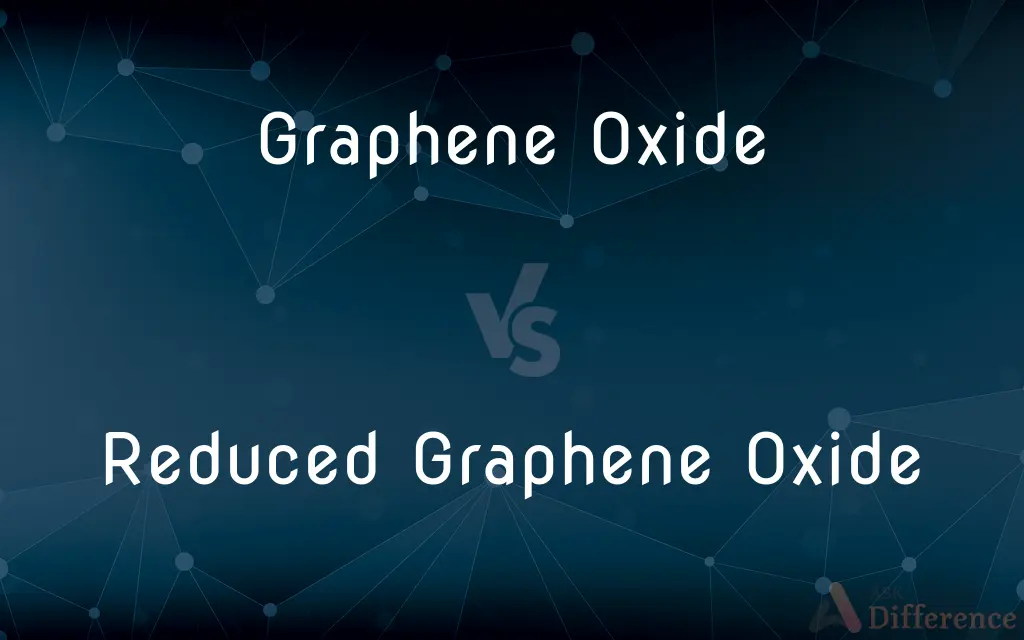Graphene Oxide vs. Reduced Graphene Oxide — What's the Difference?
By Tayyaba Rehman — Published on January 10, 2024
Graphene Oxide (GO) is graphene with oxygen-containing groups, making it dispersible in water. Reduced Graphene Oxide (rGO) is GO that's chemically reduced, partially removing these groups.

Difference Between Graphene Oxide and Reduced Graphene Oxide
Table of Contents
ADVERTISEMENT
Key Differences
Chemical Composition: Graphene Oxide is a single-atomic-layered material derived from graphite, functionalized with oxygen-containing groups such as epoxides, hydroxyls, and carboxyls. Reduced Graphene Oxide is produced by the chemical reduction of Graphene Oxide, which partially removes these oxygen-containing groups, restoring some of the properties of pristine graphene.
Physical Properties: The presence of oxygen groups in Graphene Oxide disrupts the sp2 bonding network, affecting its electrical conductivity. Reduced Graphene Oxide, with fewer oxygen groups, regains some of the electrical conductivity and hydrophobic properties of graphene, although not to the full extent of pure graphene.
Solubility and Dispersion: Graphene Oxide is highly dispersible in water and other solvents due to the presence of oxygen functional groups, which is not typically the case with pristine graphene. Reduced Graphene Oxide, while less dispersible than GO, still maintains better solubility compared to pure graphene, due to the remaining oxygen groups.
Applications: Graphene Oxide's functional groups make it suitable for applications like drug delivery, sensors, and composite materials. Reduced Graphene Oxide, with its improved electrical properties, finds use in electronic devices, energy storage, and as a conductive additive in materials.
Production and Processing: The production of Graphene Oxide involves the oxidation of graphite, which is an accessible and scalable process. The reduction of Graphene Oxide to form Reduced Graphene Oxide can be achieved through various chemical, thermal, or electrochemical methods, each influencing the properties of the final product.
ADVERTISEMENT
Comparison Chart
Oxygen Content
High, with many oxygen-containing groups.
Lower, with partial removal of oxygen groups.
Electrical Conductivity
Lower due to disrupted sp2 bonding.
Higher than GO, but less than pure graphene.
Solubility
Highly dispersible in water and solvents.
Less dispersible than GO, more than graphene.
Applications
Used in biomedicine, sensors, composites.
Suitable for electronics, energy storage.
Production Method
Produced by oxidizing graphite.
Made by chemically reducing Graphene Oxide.
Compare with Definitions
Graphene Oxide
Graphene Oxide has disrupted sp2 bonding, affecting its electrical properties.
Reduced Graphene Oxide
Reduced Graphene Oxide is Graphene Oxide that has been chemically reduced.
Reduced Graphene Oxide was used to fabricate a flexible touch screen.
Graphene Oxide
Graphene Oxide was utilized in a drug delivery system due to its functional groups.
Reduced Graphene Oxide
Reduced Graphene Oxide finds applications in electronics and energy storage.
The company used Reduced Graphene Oxide in the development of a supercapacitor.
Graphene Oxide
Graphene Oxide is a chemically modified form of graphene with oxygen functional groups.
Graphene Oxide was used to enhance the strength of polymer composites.
Reduced Graphene Oxide
The reduction process partially removes oxygen-containing groups from Graphene Oxide.
Reduced Graphene Oxide's improved conductivity made it ideal for electronic circuits.
Graphene Oxide
Graphene Oxide can be produced from graphite through chemical oxidation.
The lab synthesized Graphene Oxide for use in sensor applications.
Reduced Graphene Oxide
Reduced Graphene Oxide regains some electrical conductivity compared to GO.
In the battery, Reduced Graphene Oxide served as an efficient electrode material.
Graphene Oxide
Graphene Oxide is an intermediary product in the production of Reduced Graphene Oxide.
Graphene Oxide sheets were processed to create membranes for filtration.
Reduced Graphene Oxide
Reduced Graphene Oxide maintains better solubility than graphene but less than GO.
Reduced Graphene Oxide was employed in a composite material for enhanced strength.
Graphene Oxide
Graphene Oxide exhibits unique properties due to the presence of oxygen groups.
Graphene Oxide's solubility in water makes it useful for producing conductive inks.
Common Curiosities
What is Graphene Oxide?
A chemically modified graphene with oxygen-containing groups.
What is the reduction process in Reduced Graphene Oxide?
It involves chemical, thermal, or electrochemical methods.
What applications does Reduced Graphene Oxide have?
Used in electronics, energy storage, and conductive materials.
Can Reduced Graphene Oxide be used in batteries?
Yes, especially as an electrode material.
Are the properties of Reduced Graphene Oxide similar to graphene?
Partially, but it doesn't fully regain graphene's properties.
How is Reduced Graphene Oxide different from Graphene Oxide?
It's chemically reduced, partially removing oxygen groups.
What are the uses of Graphene Oxide?
It's used in biomedicine, sensors, and composite materials.
How is Graphene Oxide made?
By chemically oxidizing graphite.
Is Graphene Oxide electrically conductive?
Its conductivity is lower due to disrupted sp2 bonding.
Is Reduced Graphene Oxide soluble in water?
It's less soluble than GO, but more than pure graphene.
Does Graphene Oxide have a layered structure?
Yes, similar to graphene but with oxygen groups.
Can Graphene Oxide be used in drug delivery?
Yes, its functional groups make it suitable for drug delivery.
Can Graphene Oxide dissolve in water?
Yes, it's highly dispersible in water.
Does Reduced Graphene Oxide conduct electricity?
Yes, it regains some conductivity after reduction.
What affects the properties of Reduced Graphene Oxide?
The method and extent of reduction process.
Share Your Discovery

Previous Comparison
Natural Ecosystem vs. Artificial Ecosystem
Next Comparison
Prophase 1 vs. Prophase 2Author Spotlight
Written by
Tayyaba RehmanTayyaba Rehman is a distinguished writer, currently serving as a primary contributor to askdifference.com. As a researcher in semantics and etymology, Tayyaba's passion for the complexity of languages and their distinctions has found a perfect home on the platform. Tayyaba delves into the intricacies of language, distinguishing between commonly confused words and phrases, thereby providing clarity for readers worldwide.
















































